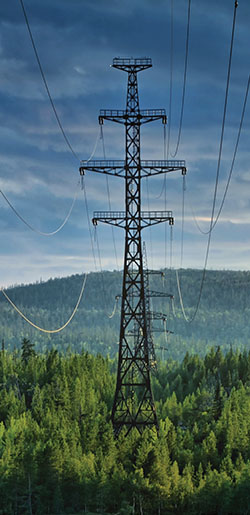 Researchers have identified ways that power line right-of-ways can be important reservoirs for disappearing habitat
Researchers have identified ways that power line right-of-ways can be important reservoirs for disappearing habitat
Underneath power lines is probably not the first place that comes to mind when thinking of important wildlife habitat, since power lines have well-known, negative impacts on ecosystems. For example, when routed through forests they cause fragmentation, creating barriers for species that cannot cross through open areas and reducing the amount of habitat for species dependent on the interiors of forests, such as the scarlet tanager. They can also create pathways for invasive species to penetrate into forest communities. And wildlife effects are not just limited to forest species: power lines create a collision and electrocution danger for birds wherever they are found, especially for birds like grouse, cranes, pelicans and herons that have a high weight-to- wing-area ratio, limiting their maneuverability when in flight. Recent estimates suggest that 12 million to 64 million bird deaths per year are caused by power line collisions or electrocutions in the United States.
Given such detrimental effects, these lines would not exist in an ideal world, but the reality is that power lines are a feature of our current landscape and will be for the foreseeable future. More lines may even be necessary to transition to a cleaner and more distributed energy future so we can combat the severe environmental impacts of climate change. A reasonable question then is whether there a way to have transmission lines that are not so detrimental to our natural environment.
New Research
A growing body of research is showing how power line and other utility right-of-ways (ROWs; the areas along and to either side of a line) do not have to have a purely negative impact on wildlife, but have the potential to promote biodiversity and protect imperiled species if managed properly. Following a disturbance like a fire or logging, there is a natural progression of plant and animal communities that develop in an area, in a process called ecological succession. Smaller, sun-loving and fast-growing plants like grasses, forbs (non-woody, non-grass plants like wildflowers) and shrubs dominate early stages of succession. Absent another disturbance to restart the succession process, these early successional communities will eventually give way to a stable, forested community as trees become established in the area.
In the eastern United States there has been a substantial decline in early successional habitat due to things like land conversion to developed or intensive agricultural uses and fire suppression, which prevents natural land from being reset back to an earlier stage. As early successional habitat disappears, so does the wildlife that depend on it.
A growing body of research shows how power line and other utility right-of-ways have the potential to promote biodiversity and protect imperiled species if managed properly.
Recently, researchers have identified power line ROWs as an important reservoir of this disappearing habitat. To safely and reliably provide electricity, transmission companies must control tree growth underneath and adjacent to power lines to prevent trees from either growing into the wires or falling onto the wires, causing power outages. This means that power line ROW vegetation is perpetually maintained in an early successional stage. Indeed, several studies have documented how ROWs can support productive populations of early successional wildlife not found in nearby habitat types. Importantly, this includes species whose populations are in decline such as some grass- and shrubland birds, butterflies and pollinators like bees.
Proper maintenance is key
Of course, such biodiversity benefits depend on ROWs being maintained to promote this kind of habitat. ROWs are turned into ecological deserts if managed too aggressively, such as simply mowing and broadcast-spraying herbicides edge to edge. While power line companies are required to maintain minimum clearance distances between vegetation and transmission wires, beyond these minimum clearances, there are no specific rules in Wisconsin for how the vegetation should be maintained.
One approach to managing ROW vegetation that has been found to promote wildlife habitat while still ensuring safe and reliable electricity transmission is the wire zone/border zone approach. The basic concept of this approach is to divide the ROW into two distinct zones: the wire zone under the transmission wires and border zones extending out from either side of the wire zone to the edge of the ROW. In the wire zone, herb-grass-forb cover types are promoted, while shrubs and short trees are allowed in the border zone. Creating two distinct zones and allowing some vertical structure in the form of low-growing woody plants creates habitat complexity to support a variety of wildlife. There are also examples of more targeted management aimed at promoting habitat for specific species, such as efforts in New York to promote lupine habitat for the endangered Karner Blue butterfly in power line ROWs.
There are approximately 12,000 miles of transmission lines in Wisconsin, and this number is likely to increase in the future. However, proper siting of those lines can reduce impacts to sensitive ecosystems, and these recent studies show that not all of the land disturbed for these lines needs to be written off as poor wildlife habitat; rather with appropriate vegetation management, these ROWs can play an important role in promoting biodiversity. Locally, Clean Wisconsin is working with the PSC to better understand how power lines are currently being managed in the state in order to identify areas for improvement and to establish a set of environmentally responsible best practices for power line management.
By Paul Mathewson, Staff Scientist
